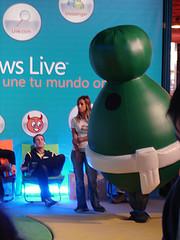Universities Language
 Initially, the use of computer science in the schools, initiated for the secretariats, for administrative use, searching to follow the technological development and to improve the quality and pontualidade of the processes in the organizacional scope. with passing of the time, the computer was also taking another environment pertaining to school, normally called ' ' laboratory of informtica' '. The evolution of the use of the computers in the pertaining to school environment migra, of the secretariat for the computer science laboratories, Brave (1999) affirms that, ' ' the politics and proposals pedagogical of computer science in the education, in Brazil they had always been basically in research carried through in the Universities in function of the schools of the net pblica' ' starting, in the decade of 1970, if to develop through movements that Simo Grandson (2002), flame of waves. The first wave, for the author, was SOON and the programming. SOON it is a programming language created for Seymour Papert, that contributes for the learning of mathematical concepts. Seymour Papert, as Gregolin (1994) worked with Piaget during five years investigating the evolution and nature of the infantile thought. In 1964 of Technology/EUZ was changed for MIT (Massachussets Institute, where it planned a language that could be used by the children having at the same time available capacity of processing and resources to the user as the professional languages.
Initially, the use of computer science in the schools, initiated for the secretariats, for administrative use, searching to follow the technological development and to improve the quality and pontualidade of the processes in the organizacional scope. with passing of the time, the computer was also taking another environment pertaining to school, normally called ' ' laboratory of informtica' '. The evolution of the use of the computers in the pertaining to school environment migra, of the secretariat for the computer science laboratories, Brave (1999) affirms that, ' ' the politics and proposals pedagogical of computer science in the education, in Brazil they had always been basically in research carried through in the Universities in function of the schools of the net pblica' ' starting, in the decade of 1970, if to develop through movements that Simo Grandson (2002), flame of waves. The first wave, for the author, was SOON and the programming. SOON it is a programming language created for Seymour Papert, that contributes for the learning of mathematical concepts. Seymour Papert, as Gregolin (1994) worked with Piaget during five years investigating the evolution and nature of the infantile thought. In 1964 of Technology/EUZ was changed for MIT (Massachussets Institute, where it planned a language that could be used by the children having at the same time available capacity of processing and resources to the user as the professional languages.
To this language it called SOON. For Papert (1985), the resource must be used to develop the applicable ability of the use of the computer and knowledge to the proper life. ' ' The paper that I attribute to the computer is of a carrier of embryos or the cultural seeds whose intellectual products will not need taken root technological support a time in a mind that grows ativamente.' ' (PAPERT, 1985, P. 23) SOON it has a proposal pedagogical construcionista guided for a epistemolgica vision.